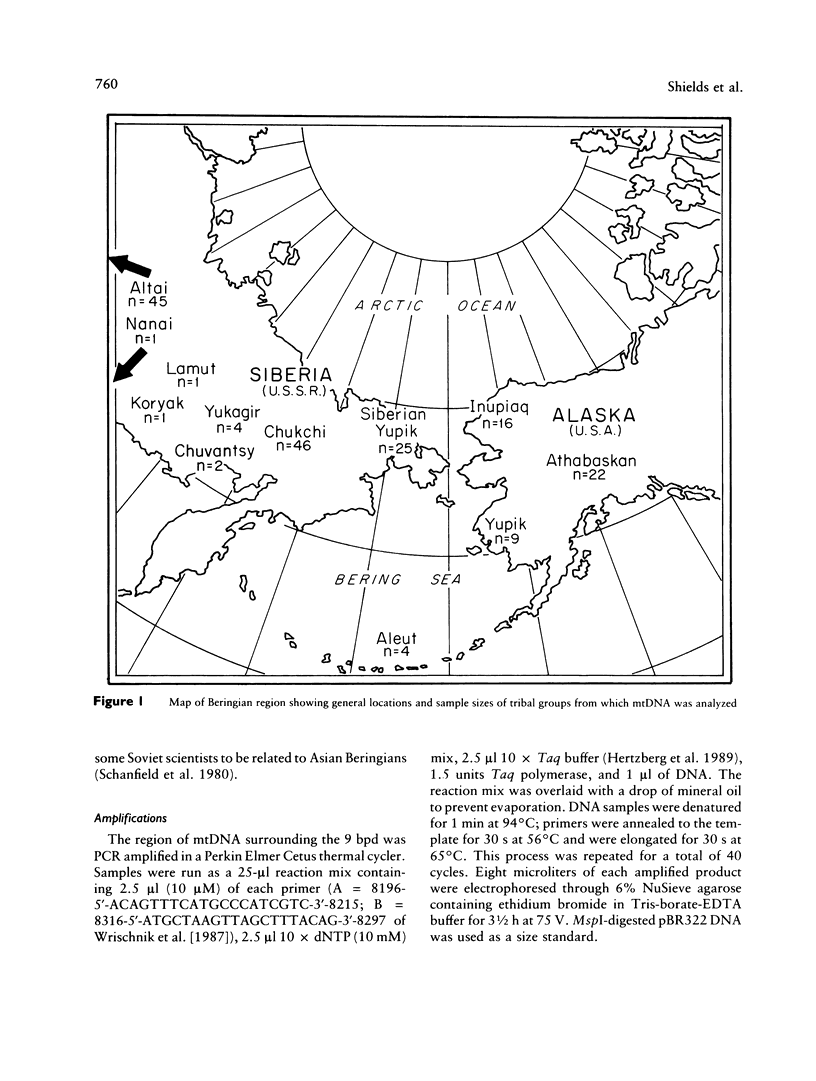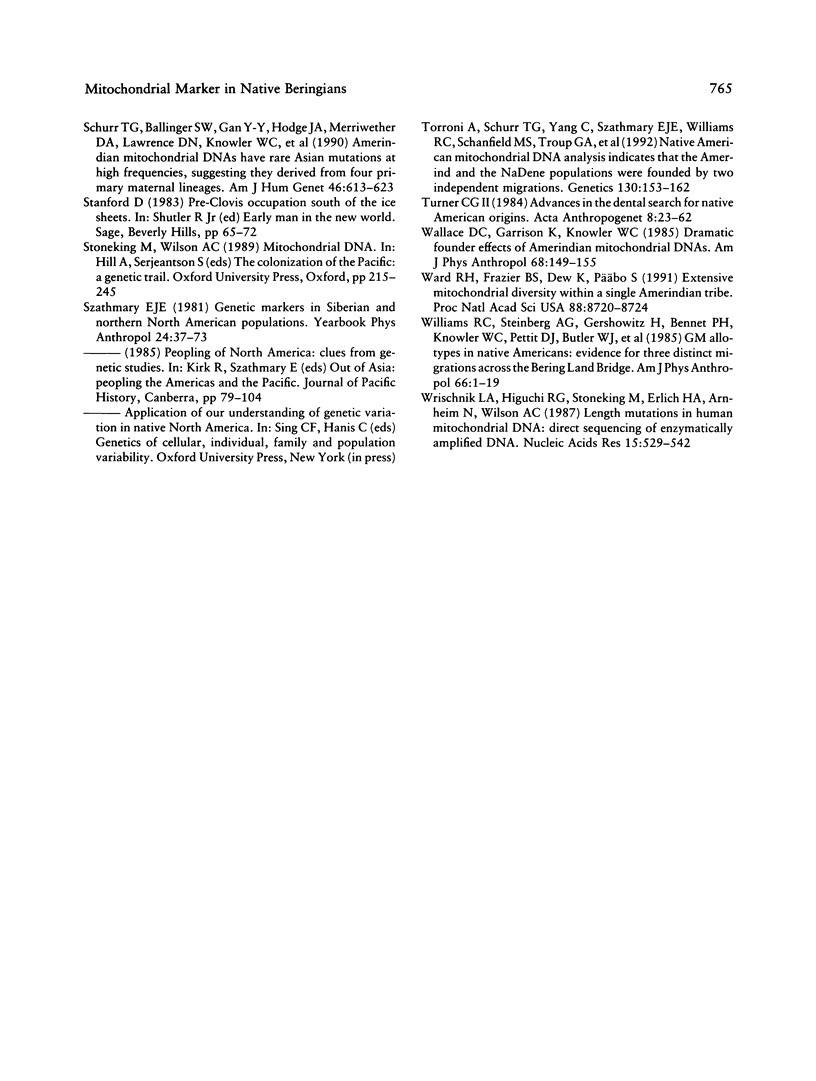Abstract
The Asian-specific 9-bp deletion between the genes for mitochondrial cytochrome oxidase II and lysine transfer RNA has been used to trace aboriginal human movements out of Southeast Asia and into portions of the South Pacific. Although it has been used to estimate the number of independent lineages that occur in the New World, it has not been studied in native peoples of the Beringian region. Thus, we have used PCR to amplify and compare the lengths of DNA segments surrounding this deletion in native peoples of Beringia and the adjacent regions, as well as natives of the Altai Mountains of Southwestern Siberia. Of the 176 individuals analyzed here, the deletion was found in only 3 of 25 individuals from the Ust-Kan region of the Altai Mountains. We comment on the distribution of this marker and on potential relationships between Beringians and other Native American groups in which this marker has been surveyed. One Chukchi possessed three copies of the 9-bp sequence, which suggests (1) that the number of copies of this sequence in humans may be more variable than had been believed and (2) that a mechanism of replication based on tandem duplication may be a potential explanation for the origin of this length mutation in humans.
Full text
PDF







Images in this article
Selected References
These references are in PubMed. This may not be the complete list of references from this article.
- Bada J. L., Gillespie R., Gowlett J. A., Hedges R. E. Accelerator mass spectrometry radiocarbon ages of amino acid extracts from Californian palaeoindian skeletons. 1984 Nov 29-Dec 5Nature. 312(5993):442–444. doi: 10.1038/312442a0. [DOI] [PubMed] [Google Scholar]
- Cann R. L., Wilson A. C. Length mutations in human mitochondrial DNA. Genetics. 1983 Aug;104(4):699–711. doi: 10.1093/genetics/104.4.699. [DOI] [PMC free article] [PubMed] [Google Scholar]
- Carr S. M., Griffith O. M. Rapid isolation of animal mitochondrial DNA in a small fixed-angle rotor at ultrahigh speed. Biochem Genet. 1987 Jun;25(5-6):385–390. doi: 10.1007/BF00554547. [DOI] [PubMed] [Google Scholar]
- Hertzberg M., Mickleson K. N., Serjeantson S. W., Prior J. F., Trent R. J. An Asian-specific 9-bp deletion of mitochondrial DNA is frequently found in Polynesians. Am J Hum Genet. 1989 Apr;44(4):504–510. [PMC free article] [PubMed] [Google Scholar]
- Horai S., Matsunaga E. Mitochondrial DNA polymorphism in Japanese. II. Analysis with restriction enzymes of four or five base pair recognition. Hum Genet. 1986 Feb;72(2):105–117. doi: 10.1007/BF00283927. [DOI] [PubMed] [Google Scholar]
- Päbo S., Gifford J. A., Wilson A. C. Mitochondrial DNA sequences from a 7000-year old brain. Nucleic Acids Res. 1988 Oct 25;16(20):9775–9787. doi: 10.1093/nar/16.20.9775. [DOI] [PMC free article] [PubMed] [Google Scholar]
- Sanger F., Nicklen S., Coulson A. R. DNA sequencing with chain-terminating inhibitors. Proc Natl Acad Sci U S A. 1977 Dec;74(12):5463–5467. doi: 10.1073/pnas.74.12.5463. [DOI] [PMC free article] [PubMed] [Google Scholar]
- Schanfield M. S., Alexeyeva T. E., Crawford M. H. Studies on the immunoglobulin allotypes of asiatic populations. VIII. Immunoglobulin allotypes among the Tuvinians of the USSR. Hum Hered. 1980;30(6):343–349. doi: 10.1159/000153155. [DOI] [PubMed] [Google Scholar]
- Schurr T. G., Ballinger S. W., Gan Y. Y., Hodge J. A., Merriwether D. A., Lawrence D. N., Knowler W. C., Weiss K. M., Wallace D. C. Amerindian mitochondrial DNAs have rare Asian mutations at high frequencies, suggesting they derived from four primary maternal lineages. Am J Hum Genet. 1990 Mar;46(3):613–623. [PMC free article] [PubMed] [Google Scholar]
- Torroni A., Schurr T. G., Yang C. C., Szathmary E. J., Williams R. C., Schanfield M. S., Troup G. A., Knowler W. C., Lawrence D. N., Weiss K. M. Native American mitochondrial DNA analysis indicates that the Amerind and the Nadene populations were founded by two independent migrations. Genetics. 1992 Jan;130(1):153–162. doi: 10.1093/genetics/130.1.153. [DOI] [PMC free article] [PubMed] [Google Scholar]
- Turner C. G., 2nd Advances in the dental search for Native American origins. Acta Anthropogenet. 1984;8(1-2):23–78. [PubMed] [Google Scholar]
- Wallace D. C., Garrison K., Knowler W. C. Dramatic founder effects in Amerindian mitochondrial DNAs. Am J Phys Anthropol. 1985 Oct;68(2):149–155. doi: 10.1002/ajpa.1330680202. [DOI] [PubMed] [Google Scholar]
- Ward R. H., Frazier B. L., Dew-Jager K., Päbo S. Extensive mitochondrial diversity within a single Amerindian tribe. Proc Natl Acad Sci U S A. 1991 Oct 1;88(19):8720–8724. doi: 10.1073/pnas.88.19.8720. [DOI] [PMC free article] [PubMed] [Google Scholar]
- Williams R. C., Steinberg A. G., Gershowitz H., Bennett P. H., Knowler W. C., Pettitt D. J., Butler W., Baird R., Dowda-Rea L., Burch T. A. GM allotypes in Native Americans: evidence for three distinct migrations across the Bering land bridge. Am J Phys Anthropol. 1985 Jan;66(1):1–19. doi: 10.1002/ajpa.1330660102. [DOI] [PubMed] [Google Scholar]
- Wrischnik L. A., Higuchi R. G., Stoneking M., Erlich H. A., Arnheim N., Wilson A. C. Length mutations in human mitochondrial DNA: direct sequencing of enzymatically amplified DNA. Nucleic Acids Res. 1987 Jan 26;15(2):529–542. doi: 10.1093/nar/15.2.529. [DOI] [PMC free article] [PubMed] [Google Scholar]





